Figure 1, Soybean Growth Stages illustrates plant growth stages from emergence to full maturity. The system used to describe soybean growth stages divides plant development into two stages: vegetative (V) — leaves and nodes — and reproductive (R) — flowers, pods and seeds. The V stage refers to the number of nodes on the main stem with fully developed leaves, beginning with the unifoliate node. A leaf is considered fully developed when the leaflets on the node above have unrolled far enough that their edges are not touching. For example, V1 refers to the stage when the unifoliate node has a fully developed leaf, meaning that the leaf above that node (first trifoliate) is unrolled. This stage is commonly referred to as the “first trifoliate” stage because the first trifoliate (compound leaf) is unrolled. The node is the place on the stem where the leaf is attached. Trifoliate leaves on branches are not counted when determining V stages. Soybean varieties grown in Ontario are indeterminate (they continue to grow taller, produce new trifoliates, and nodes after flowering has started). Although technically, the V stages continue as long as the plant produces new trifoliates, once flowering has initiated trifoliates are no longer counted when staging soybeans. R3 through R6 growth stages are based on the top 4 nodes, not the bottom part of the plant. A field has reached a given growth stage when at least 50% of plants have attained that stage.
Figure 1A. Soybean Growth Stages (Vegetative)
| Vegetative | |||
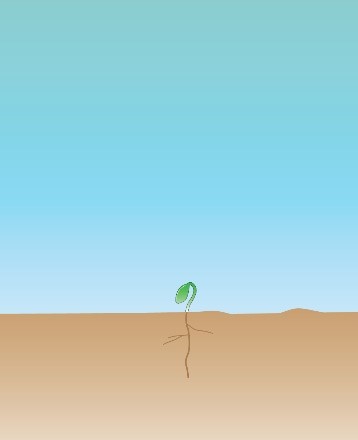 | 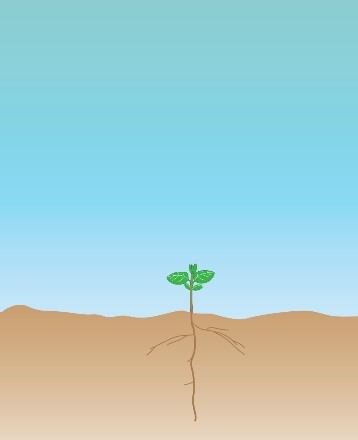 | 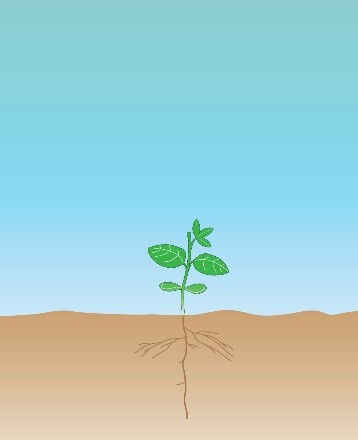 | 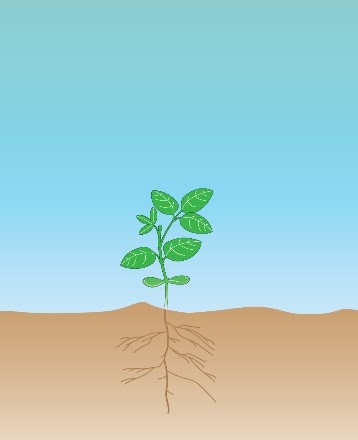 |
| VE | VC | V1 | V2* |
| Emergence | Cotyledon (commonly referred to as the “unifoliate” stage) | First trifoliate | Second trifoliate |
| Seeding (cotyledons) emerge from the soil. | Unifoliate leaves are unrolled (leaf edges are no longer touching). | First trifoliate unrolled (fully developed leaves at the unifoliate node). | Two trifoliates unrolled. *Subsequent vegetative stages triggered by unrolled trifoliates (V3, V4, etc.) |
Illustrations were provided by Kansas State University. Ciampitti, I. A. (2017). Soybean Growth and Development. Kansas State University.
Figure 1B. Soybean Growth Stages (Reproductive)
| Reproductive | |||||||
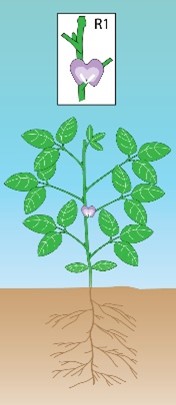 | 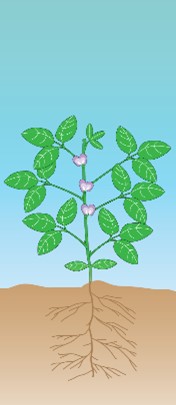 | 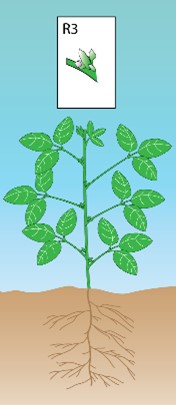 | 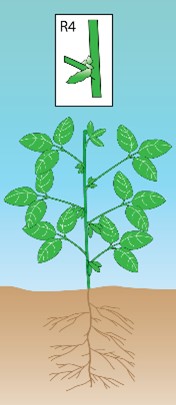 | 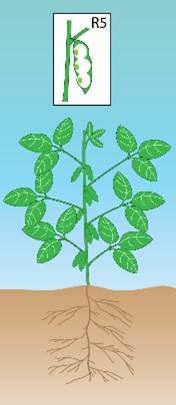 | 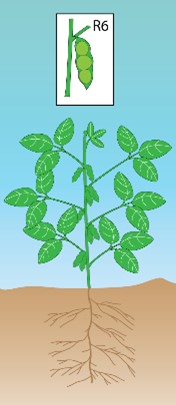 | 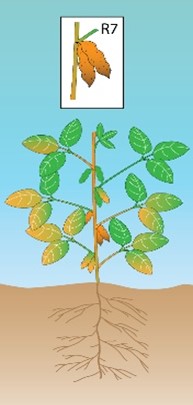 | 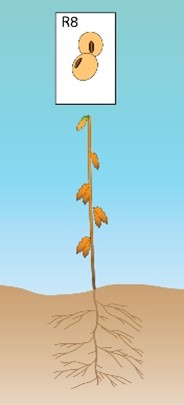 |
| R1 | R2 | R3 | R4 | R5 | R6 | R7 | R8 |
| Beginning Flowering | Full Flowering | Beginning Pod | Full Pod | Beginning Seed | Full Seed | Beginning Maturity | Full Maturity |
| One open flower anywhere on the main stem is visible. | One open flower on one of the two uppermost nodes on the main stem. | Pods are 5mm (3/16 of an inch) long on one of the four uppermost nodes on the main stem with a fully developed leaf. | Pods are 19mm (3/4 of an inch) long on one of the four uppermost nodes on the main stem with a fully developed leaf. | Seed 3mm (1/8 of an inch) long on one of the four uppermost nodes on the main stem with a fully developed leaf. | Green seed that fills the cavity of a pod on one of the four uppermost nodes on the main stem with a fully developed leaf. | One pod on the main stem has reached mature pod colour. Plants are considered physiologically mature at this stage. | 95% of pods have reached mature pod colour. (usually brown) |
Illustrations were provided by Kansas State University. Ciampitti, I. A. (2017). Soybean Growth and Development. Kansas State University.
Emergence (VE)
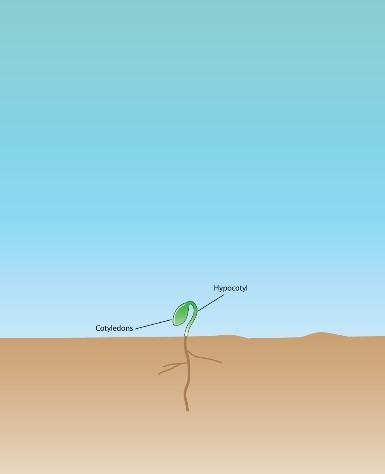
Germination begins with the seed absorbing soil moisture until it reaches a moisture content of 50%. The first external sign of germination is the appearance of the radicle (primary root), which grows downward and anchors itself in the soil. Shortly after, the hypocotyl (the section of the stem above the radicle) starts growing upwards, pulling the cotyledons (seed leaves) with it. When 50% of the cotyledons have emerged through the soil surface the field has reached the VE stage. Planting depth, soil type, variety, moisture, and temperature all play a role in the length of time it takes soybeans to emerge. A general rule of thumb is that approximately 150 GDD (growing degree days) are necessary for soybeans to reach VE. This could take as little as 5 days to as long as 40 days. Root hairs develop soon after germination. Root hairs are essential to water absorption, nutrient uptake, and nodule formation by rhizobium.
Cotyledon (VC) or Unifoliate
Once emerged, the hook-shaped hypocotyl straightens, the cotyledons unfold, and the growing point is exposed to sunlight. The first two leaves of the soybean plant are unifoliates (each is a single leaf) occurring opposite each other at the first node, above the cotyledons. A field has reached the VC stage when the unifoliates leaf edges have expanded to the point where the leaf edges are no longer touching. This stage is commonly referred to as the unifoliate leaf stage. The cotyledons are the main nutrient reservoir for young plants for up to 10 days after emergence.
First trifoliate (V1)
A trifoliate leaf now develops and unrolls. Once its leaf edges are no longer toughing the plant has reached V1 (fully developed leaves at the unifoliate node). New leaves above the unifoliates will all be trifoliate (three leaflets per leaf) and develop on alternate sides of the stem. The plant becomes self-sustaining as newly developed leaves begin photosynthesis. New trifoliates appear every 3-5 days depending on growing conditions.
Second trifolate (V2) – N trifoliate (Vn)
Two trifoliates are now unrolled at nodes above the unifoliate node. Subsequent V stages are determined by counting the number of trifoliate leaves with unrolled leaflets on the main stem before flowering is initiated. Once flowering has started the number of trifoliates are no longer counted when determining soybean growth stages. The number of trifoliates a plant will attain (Vn) before flowering is determined by factors such as planting date, variety, and growing conditions. Late planted soybeans or extremely short season varieties may start to flower as early as V3. Ideally, 5-7 trifoliates should be present before flowering begins to maximize yield in Ontario.
Beginning Flowering (R1)
The plant has one visible flower open at any node on the main stem. Soybean plants start flowering at mid canopy and flower upwards and then downwards on the plant. Flowering is triggered mainly by day length and temperature changes. Very short season varieties are nearly insensitive to day length. Instead, flowering is controlled mainly by accumulated heat. Later maturing varieties (maturity group 1 or higher) are influenced more by day length as well as temperature. Therefore, a late planted, long season variety takes fewer days to mature than the same variety planted early by adjusting to the growing season. Short season varieties (maturity group 0 or less) have less ability to adapt to the season since they are less photoperiod sensitive.
Full Flowering or Bloom (R2)
The plant has one open flower on one of the two uppermost nodes on the main stem with a fully developed leaf. At this point 50% height and dry weight accumulation is reached. The impact of extreme heat or prolonged drought during the reproductive growth stages impacts yield significantly more than during the vegetative stages. However, because soybean flower for up to 6 weeks a short period of plant stress can be overcome by subsequent good growing conditions. For instance, one good rainfall during the month of August will impact yield more than several weeks of dry weather in July. Typically, up to 60% of the flowers and pods a soybean plant produces are aborted and do not contribute to yield.
Beginning Pod (R3)
Pods are 5mm (3/16 of an inch) long on one of the four uppermost nodes on the main stem with a fully developed leaf. Flowering begins to peak at this stage. Figure 2, Pod Stages illustrates pod formation and maturation.
 Full Pod (R4)
Full Pod (R4)
Pods are now 19mm (3/4 of an inch) long on one of the four uppermost nodes on the main stem with a fully developed leaf. Prolonged plant stress between R4 and R6 will result in significant yield losses. Peak water use can reach 3 inches per week at this stage.
 Beginning Seed (R5)
Beginning Seed (R5)
Seed is 3mm (1/8 of an inch) long on one of the four uppermost nodes on the main stem with a fully developed leaf. Primary and lateral root growth is strong until about R5. Shallow roots begin to degenerate, but deeper roots and laterals grow well into R6. The plant reaches it maximum height and leaf area. The maximum number of nodes is reached. Nitrogen fixation rates peak and begin to decline. Rapid nutrient uptake and redistribution to pods occurs. As pods mature, they become less prone to abort.
Full Seed (R6)
Green seed fills the cavity of the pod in one of the four uppermost nodes on the main stem. Figure 3, Seed-filling Process illustrates seed moisture at various growth stages. Flowering has mainly finished by this stage. Most nutrients have been taken up and root growth slows dramatically. Leaf yellowing begins and leaves in the lower canopy begin to drop. As the plant matures past R6, the potential degree of yield reduction by stress decreases. By the time the plant reaches R7 plant stress has essentially no impact on yield.
 Beginning Maturity (R7)
Beginning Maturity (R7)
One pod on the main stem has reached pod colour (no longer has any green). This mature colour is usually brown or tan. On an individual pod basis, R7 occurs when the pod wall membrane no longer clings to the seeds but stays attached to the pod wall. This pod membrane status is an observable marker of soybean seed physiological maturity. This marks the end of dry matter accumulation. This stage is equivalent to black layer formation at the base of a corn kernel, a marker of corn seed physiological maturity.
Full Maturity (R8)
95% of the pods have reached mature pod colour (brown or tan). This stage occurs 7-14 days before harvest moisture is reached.
Figure 2. Pod Stages and Maturation.
Figure 3. Seed Filling Process
Seed moisture drops gradually from R6 to R8. Once seed has reached a moisture content below 20% it can drop quickly over a short period of time.
References
1. Ciampitti, I. A. (2017). Soybean Growth and Development. Kansas State University.